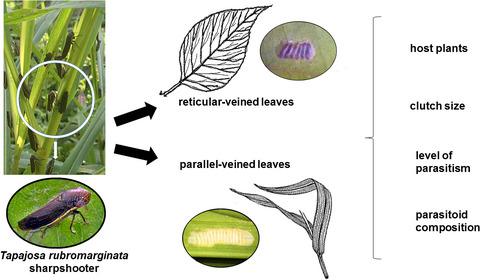当前位置:
X-MOL 学术
›
Entomol. Exp. Appl.
›
论文详情
Our official English website, www.x-mol.net, welcomes your
feedback! (Note: you will need to create a separate account there.)
The relationship among host plant species, egg clutch size, and level of parasitism for the sharpshooter Tapajosa rubromarginata
Entomologia Experimentalis et Applicata ( IF 1.4 ) Pub Date : 2020-11-07 , DOI: 10.1111/eea.12988 Eduardo G. Virla 1, 2 , María B. Aguirre 3 , Guido A. Van Nieuwenhove 1, 2 , Erica B. Luft Albarracin 2 , Guillermo A. Logarzo 3
Entomologia Experimentalis et Applicata ( IF 1.4 ) Pub Date : 2020-11-07 , DOI: 10.1111/eea.12988 Eduardo G. Virla 1, 2 , María B. Aguirre 3 , Guido A. Van Nieuwenhove 1, 2 , Erica B. Luft Albarracin 2 , Guillermo A. Logarzo 3
Affiliation

|
The sharpshooter Tapajosa rubromarginata (Signoret) (Hemiptera: Cicadellidae, Proconiini), a vector of the bacterium Xylella fastidiosa Wells et al. (Xanthomonadaceae) that causes citrus variegated chlorosis, has more than 30 reported host plant species. The fitness of a phytophagous insect is determined by the host plant suitability, plant resistance, and the natural enemies. The aim of this study was to: (1) identify plant species utilized as oviposition substrate by T. rubromarginata in the field; (2) establish the relationship between plants and clutch size; (3) establish the relationship among host plants, clutch size, and level of parasitism; and (4) establish variations in parasitoid composition and abundance in the various host plants. Egg masses of the sharpshooter were surveyed on plants reported as hosts, or those that were abundant in the study site. The number of eggs of the sharpshooter and emerged parasitoids were recorded for all the collected masses. We found egg masses of T. rubromarginata on 12 out of 21 plant species sampled. The size of the egg masses was greatly influenced by the type of leaf venation and to a lesser extent by the plant species. Parasitism rates were influenced by both leaf venation and host plant. Trichogrammatidae species were mostly associated with egg masses in plants with parallel‐veined leaves, whereas Mymaridae attacked masses laid in reticular‐veined leaves. The choice between a good host plant, but heavily attacked by parasitoids, and the host plants that are less suitable for nymphs but less frequently attacked by natural enemies, was a trade‐off for T. rubromarginata females to increase their fitness. We conclude that the host plant utilization by T. rubromarginata females in the field could be influenced by leaf structure and the strategy to avoid parasitism by selecting plants that were less attractive for parasitoids.
中文翻译:

神枪手 Tapajosa rubromarginata 寄主植物种类、卵窝大小和寄生水平之间的关系
神枪手 Tapajosa rubromarginata (Signoret) (半翅目: Cicadellidae, Proconiini),一种细菌 Xylella fastidiosa Wells 等人的载体。引起柑橘杂色萎黄病的黄单胞菌科 (Xanthomonadaceae) 有 30 多种已报道的寄主植物物种。植食性昆虫的适应性取决于寄主植物的适宜性、植物抗性和天敌。本研究的目的是: (1) 鉴定田间被T. rubromarginata用作产卵底物的植物物种;(2) 建立植株与离合器大小的关系;(3) 建立寄主植物、离合器大小和寄生水平之间的关系;(4) 在各种寄主植物中建立寄生蜂组成和丰度的变化。神枪手的卵块在报告为宿主的植物上进行了调查,或那些在研究地点丰富的。记录所有收集到的群体的神枪手和出现的寄生蜂的卵数。我们在采样的 21 种植物中的 12 种上发现了 T. rubromarginata 的卵块。卵块的大小受叶脉类型的影响很大,受植物种类的影响较小。寄生率受叶脉和寄主植物的影响。Trichogrammatidae 物种主要与具有平行脉叶的植物中的卵团有关,而 Mymaridae 攻击产于网状脉叶中的团块。在受寄生物严重攻击的良好寄主植物和不太适合若虫但较少受到天敌攻击的寄主植物之间的选择是 T. rubromarginata 雌性提高其适应性的一种权衡。
更新日期:2020-11-07
中文翻译:

神枪手 Tapajosa rubromarginata 寄主植物种类、卵窝大小和寄生水平之间的关系
神枪手 Tapajosa rubromarginata (Signoret) (半翅目: Cicadellidae, Proconiini),一种细菌 Xylella fastidiosa Wells 等人的载体。引起柑橘杂色萎黄病的黄单胞菌科 (Xanthomonadaceae) 有 30 多种已报道的寄主植物物种。植食性昆虫的适应性取决于寄主植物的适宜性、植物抗性和天敌。本研究的目的是: (1) 鉴定田间被T. rubromarginata用作产卵底物的植物物种;(2) 建立植株与离合器大小的关系;(3) 建立寄主植物、离合器大小和寄生水平之间的关系;(4) 在各种寄主植物中建立寄生蜂组成和丰度的变化。神枪手的卵块在报告为宿主的植物上进行了调查,或那些在研究地点丰富的。记录所有收集到的群体的神枪手和出现的寄生蜂的卵数。我们在采样的 21 种植物中的 12 种上发现了 T. rubromarginata 的卵块。卵块的大小受叶脉类型的影响很大,受植物种类的影响较小。寄生率受叶脉和寄主植物的影响。Trichogrammatidae 物种主要与具有平行脉叶的植物中的卵团有关,而 Mymaridae 攻击产于网状脉叶中的团块。在受寄生物严重攻击的良好寄主植物和不太适合若虫但较少受到天敌攻击的寄主植物之间的选择是 T. rubromarginata 雌性提高其适应性的一种权衡。











































 京公网安备 11010802027423号
京公网安备 11010802027423号